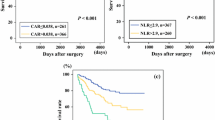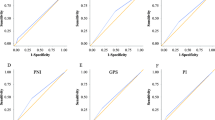Abstract
Purpose
Methods to preoperatively stratify oncological risks associated with gastric cancer (GC) are limited. Host inflammatory parameters, i.e., serum C-reactive protein (CRP) and albumin levels, are known to be associated with outcomes. We examined the relationships between disease-specific mortality and four CRP-albumin–based indices (CRP-albumin ratio [CAR], modified Glasgow prognostic score [mGPS], Osaka prognostic score [OPS], and NUn score) preoperatively measured in cases with resectable GC.
Methods
Survival outcomes of 1290 consecutive GC patients with oncological gastrectomy were reviewed. Predictive significances of preoperative CAR, mGPS, OPS, and NUn scores were assessed with time-dependent receiver operating characteristic curves and Cox regression analyses.
Results
Median follow-up was 107 months. Area under the curve for predicting overall and disease-specific survivals (OS/DSS) for the preoperative NUn score was clearly superior to those of the other parameters. On univariate Cox regression analysis, preoperative CAR, mGPS, OPS, and the NUn score all correlated significantly with OS/DSS. On multivariate Cox regression analysis, the preoperative NUn score, as a continuous variable, showed an independent relationship with OS (hazard ratio [HR] 1.32, 95% confidence interval [CI] 1.16–1.50, per 1-unit increase, P < 0.001) and even DSS (HR 1.23, 95% CI 1.02–1.49, P = 0.032). The other three markers failed to maintain independence for DSS.
Conclusions
Preoperative NUn scores are stably associated with outcomes, including disease-specific mortality, possibly serving as a simple measure to define the likelihood of progression to systemic disease after meticulous surgery for GC, which may contribute to identifying patients who would benefit from additional modalities.



Similar content being viewed by others
Data availability
The present data are not available for other studies.
Abbreviations
- CAR:
-
C-reactive protein to albumin ratio
- CRP:
-
C-reactive protein
- DSS:
-
Disease-specific survival
- GC:
-
Gastric cancer
- mGPS:
-
Modified Glasgow prognostic score
- NLR:
-
Neutrophil-to-lymphocyte ratio
- OPS:
-
Osaka prognostic score
- OS:
-
Overall survival
- PLR:
-
Platelet-to-lymphocyte ratio
- ROC:
-
Receiver operating characteristic
References
Sung H, Ferlay J, Siegel RL, Laversanne M, Soerjomataram I, Jemal A et al (2021) Global Cancer Statistics 2020: GLOBOCAN estimates of incidence and mortality worldwide for 36 cancers in 185 countries. CA Cancer J Clin 71(3):209–249
Morgan E, Arnold M, Camargo MC, Gini A, Kunzmann AT, Matsuda T et al (2022) The current and future incidence and mortality of gastric cancer in 185 countries, 2020–2040: a population-based modelling study. EClinicalMedicine 47:101404
Goetze OT, Al-Batran SE, Chevallay M, Mönig SP (2018) Multimodal treatment in locally advanced gastric cancer. Updates Surg 70(2):173–179
Oñate-Ocaña LF, Aiello-Crocifoglio V, Gallardo-Rincón D, Herrera-Goepfert R, Brom-Valladares R, Carrillo JF et al (2007) Serum albumin as a significant prognostic factor for patients with gastric carcinoma. Ann Surg Oncol 14(2):381–389
Saito H, Kono Y, Murakami Y, Shishido Y, Kuroda H, Matsunaga T et al (2018) Prognostic significance of the preoperative ratio of c-reactive protein to albumin and neutrophil-lymphocyte ratio in gastric cancer patients. World J Surg 42(6):1819–1825
Jiang X, Hiki N, Nunobe S, Kumagai K, Kubota T, Aikou S et al (2012) Prognostic importance of the inflammation-based Glasgow prognostic score in patients with gastric cancer. Br J Cancer 107(2):275–279
Fujino S, Myoshi N, Saso K, Sasaki M, Ishikawa S, Takahashi Y et al (2020) The inflammation-nutrition score supports the prognostic prediction of the TNM stage for colorectal cancer patients after curative resection. Surg Today 50(2):163–170
Noble F, Curtis N, Harris S, Kelly JJ, Bailey IS, Byrne JP et al (2012) Risk assessment using a novel score to predict anastomotic leak and major complications after oesophageal resection. J Gastrointest Surg 16(6):1083–1095
Yago A, Haruta S, Ueno M, Hamada Y, Ogawa Y, Ohkura Y et al (2021) Adequate period of surveillance in each stage for curatively resected gastric cancer: analyzing the time and rates of recurrence. Gastric Cancer 24(3):752–761
Brierley JD, Gospodarowicz MK, Wittekind C (2017) TNM classification of malignant tumours, 8th edn. Wiley-Blackwell, Oxford, UK
Lauren P (1965) The two histological main types of gastric carcinoma: diffuse and so-called intestinal-type carcinoma. An attempt at a histo-clinical classification. Acta Pathol Microbiol Scand 64:31–49
Dindo D, Demartines N, Clavien PA (2004) Classification of surgical complications: a new proposal with evaluation in a cohort of 6336 patients and results of a survey. Ann Surg 240(2):205–213
Japanese Gastric Cancer Association (2021) Japanese gastric cancer treatment guidelines 2018 (5th edition). Gastric Cancer 24(1):1–21
Kattan MW, Karpeh MS, Mazumdar M, Brennan MF (2003) Postoperative nomogram for disease-specific survival after an R0 resection for gastric carcinoma. J Clin Oncol 21(19):3647–3650
Katai H, Ishikawa T, Akazawa K, Isobe Y, Miyashiro I, Oda I et al (2018) Five-year survival analysis of surgically resected gastric cancer cases in Japan: a retrospective analysis of more than 100,000 patients from the nationwide registry of the Japanese Gastric Cancer Association (2001–2007). Gastric Cancer 21(1):144–154
Kubota T, Hiki N, Sano T, Nomura S, Nunobe S, Kumagai K et al (2014) Prognostic significance of complications after curative surgery for gastric cancer. Ann Surg Oncol 21(3):891–898
Altman DG, Royston P (2006) The cost of dichotomising continuous variables. BMJ 332(7549):1080
Alsina M, Arrazubi V, Diez M, Tabernero J (2023) Current developments in gastric cancer: from molecular profiling to treatment strategy. Nat Rev Gastroenterol Hepatol 20(3):155–170
Dvorak HF (1986) Tumors: wounds that do not heal. Similarities between tumor stroma generation and wound healing. N Engl J Med 315(26):1650–1659
McMillan DC (2009) Systemic inflammation, nutritional status and survival in patients with cancer. Curr Opin Clin Nutr Metab Care 12(3):223–226
Yamashita H, Katai H (2010) Systemic inflammatory response in gastric cancer. World J Surg 34(10):2399–2400
Fernández J, Clària J, Amorós A, Aguilar F, Castro M, Casulleras M et al (2019) Effects of albumin treatment on systemic and portal hemodynamics and systemic inflammation in patients with decompensated cirrhosis. Gastroenterology 157(1):149–162
Cederholm T, Jensen GL, Correia M, Gonzalez MC, Fukushima R, Higashiguchi T et al (2019) GLIM criteria for the diagnosis of malnutrition - a consensus report from the global clinical nutrition community. J Cachexia Sarcopenia Muscle 10(1):207–217
Kamarajah SK, Bundred J, Tan BHL (2019) Body composition assessment and sarcopenia in patients with gastric cancer: a systematic review and meta-analysis. Gastric Cancer 22(1):10–22
Acknowledgements
We thank Shotaro Aso, MD, MPH, PhD (Department of Real World Evidence, Graduate School of Medicine, The University of Tokyo) for his helpful assistance with the statistical analyses.
Author information
Authors and Affiliations
Contributions
Study conception and design: M. Urabe. Acquisition of data: all authors. Analysis and interpretation of data: M. Urabe and Y. Okumura. Drafting of manuscript: all authors. Critical revision: K. Yagi, H. Yamashita, and Y. Seto.
Corresponding author
Ethics declarations
Conflict of interest
The authors declare no competing interests.
Additional information
Publisher's Note
Springer Nature remains neutral with regard to jurisdictional claims in published maps and institutional affiliations.
Rights and permissions
Springer Nature or its licensor (e.g. a society or other partner) holds exclusive rights to this article under a publishing agreement with the author(s) or other rightsholder(s); author self-archiving of the accepted manuscript version of this article is solely governed by the terms of such publishing agreement and applicable law.
About this article
Cite this article
Urabe, M., Okumura, Y., Okamoto, A. et al. Preoperative NUn score serves as a robust predictor of overall and disease-specific survivals following radical surgery for gastric cancer. Langenbecks Arch Surg 409, 126 (2024). https://doi.org/10.1007/s00423-024-03317-9
Received:
Accepted:
Published:
DOI: https://doi.org/10.1007/s00423-024-03317-9




